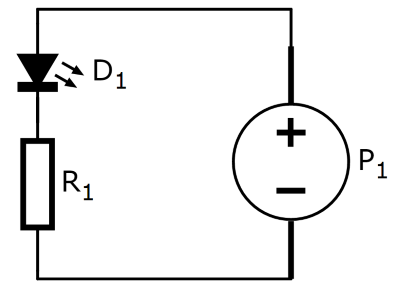Ohm's law in application
The Ohm's law is the first rule to understand to be able to connect e.g. a LED to a power supply.

Now that I have my breadboard, I'm ready to make the easiest circuit of the world : power on a LED :D
I choose a blue LED, which allow an input voltage of 2.2V with a current of 18mA.
So I cannot plug my LED directly on Vcc (here 5V). I have to add a resistor to limit current and voltage in my LED.

I think that you already know Ohm's law. I do too.
U = R * I
But for this simple circuit, do you know how to calculate R value ?
It's quite simple, but when I asked myself the question the first time, it was not clear to me that I had to choose the value of R to limit the current in the circuit.
So I want a current of 18mA, and 2.2V in my LED, and I've got a 5V input.
The resistor and the LED being connected in series, the resistor has to absorb the voltage that the LED cannot eat :
UR = UP1 - ULED = 5V - 2.2V = 3.8V
And to get 18mA in my circuit, I have to use Ohm's law to calculate R :
UR = R * I
R = UR / I = 3.8 / (18 * 10-3) = 211Ω
As I don't have such a resistor, I will use 220Ω.
Let's try it on our breadboard !

To conclude, Ohm's law allows you to define the current and the voltage of your circuit.
In next posts, I think we will see other circuits a lot more complex. This basic rule will always be used. I have a lot to learn !